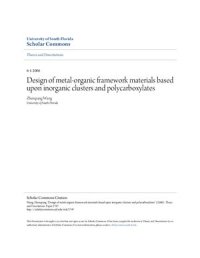
Ebook: Design of metal-organic framework materials based upon inorganic clusters and polycarboxylates
Author: Wang Zhenqiang.
- Genre: Chemistry // Organic Chemistry
- Tags: Химия и химическая промышленность, Органическая химия, Элементоорганическая химия, Металлоорганическая химия
- Language: English
- pdf
A dissertation submitted in partial fulfillment of the requirements for the degree of Doctor of Philosophy. Department of Chemistry College of Arts and Sciences University of South Florida. . 2006. – 214 p.
Keywords: crystal engineering, coordination polymers, flexibility, ligands, porosity, secondary building units, supramolecular isomerism, ternary nets, topologyNetwork structures based upon metal-organic backbones represent a new class of functional materials that can be rationally constructed by employing the concepts of supramolecular chemistry and crystal engineering. The modularity of design strategies, the diversity of prototypal structures, and the dynamic features of networks have afforded great advantages over traditional materials syntheses. The research presented in this dissertation is primarily concerned with developing an in-depth understanding of the basic principles that govern the supramolecular behaviors of metal-organic frameworks and gaining an experimental control over the structure and function of these new classes of hybrid materials.
The use of rigid and angular organic ligands along with transition metal clusters gives rise to a wide variety of novel metal-organic architectures ranging from zerodimensional nanostructures to three-dimensional frameworks. Gas sorption experiments suggest some of these compounds are potentially useful as porous materials.
Conformational analysis of these structural models reveals geometrical foundations for the existence of superstructural diversity. Controlled crystallization experiments further indicate synthetic factors that might determine the formation of supramolecular isomers.
On the other hand, careful selection of more labile organic components leads to flexible metal-organic frameworks exhibiting dynamic characteristics that have not been observed in their rigid counterparts. The guest-dependent switch-on/off of cavities and the ease of fine-tuning their chemical environments demonstrate the effectiveness of such a strategy in the context of generating tailored functional materials.
Discovery and recognition of novel three-periodic metal-organic nets remains a nontrivial exercise. In this context, rigorous topological analysis assists the understanding of complicated nets and application of geometrical principles facilitates desing of new metal-organic structures.
Finally, scaled-up metal-organic frameworks are potentially accessible with the aid of existing prototypal structures and a systematic study on ligand design.
Keywords: crystal engineering, coordination polymers, flexibility, ligands, porosity, secondary building units, supramolecular isomerism, ternary nets, topologyNetwork structures based upon metal-organic backbones represent a new class of functional materials that can be rationally constructed by employing the concepts of supramolecular chemistry and crystal engineering. The modularity of design strategies, the diversity of prototypal structures, and the dynamic features of networks have afforded great advantages over traditional materials syntheses. The research presented in this dissertation is primarily concerned with developing an in-depth understanding of the basic principles that govern the supramolecular behaviors of metal-organic frameworks and gaining an experimental control over the structure and function of these new classes of hybrid materials.
The use of rigid and angular organic ligands along with transition metal clusters gives rise to a wide variety of novel metal-organic architectures ranging from zerodimensional nanostructures to three-dimensional frameworks. Gas sorption experiments suggest some of these compounds are potentially useful as porous materials.
Conformational analysis of these structural models reveals geometrical foundations for the existence of superstructural diversity. Controlled crystallization experiments further indicate synthetic factors that might determine the formation of supramolecular isomers.
On the other hand, careful selection of more labile organic components leads to flexible metal-organic frameworks exhibiting dynamic characteristics that have not been observed in their rigid counterparts. The guest-dependent switch-on/off of cavities and the ease of fine-tuning their chemical environments demonstrate the effectiveness of such a strategy in the context of generating tailored functional materials.
Discovery and recognition of novel three-periodic metal-organic nets remains a nontrivial exercise. In this context, rigorous topological analysis assists the understanding of complicated nets and application of geometrical principles facilitates desing of new metal-organic structures.
Finally, scaled-up metal-organic frameworks are potentially accessible with the aid of existing prototypal structures and a systematic study on ligand design.
Download the book Design of metal-organic framework materials based upon inorganic clusters and polycarboxylates for free or read online
Continue reading on any device:

Last viewed books
Related books
{related-news}
Comments (0)